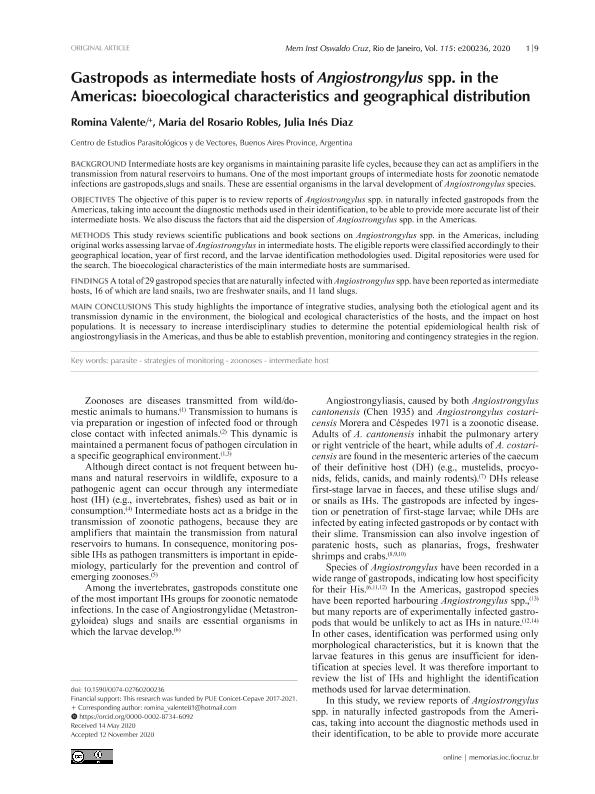Artículo
Gastropods as intermediate hosts of angiostrongylus spp: In the americas. Bioecological characteristics and geographical distribution
Fecha de publicación:
27/11/2020
Editorial:
Fundação Oswaldo Cruz
Revista:
Memórias do Instituto Oswaldo Cruz
ISSN:
1678-8060
Idioma:
Inglés
Tipo de recurso:
Artículo publicado
Clasificación temática:
Resumen
BACKGROUND Intermediate hosts are key organisms in maintaining parasite life cycles, because they can act as amplifiers in the transmission from natural reservoirs to humans. One of the most important groups of intermediate hosts for zoonotic nematode infections are gastropods,slugs and snails. These are essential organisms in the larval development of Angiostrongylus species. OBJECTIVES The objective of this paper is to review reports of Angiostrongylus spp. in naturally infected gastropods from the Americas, taking into account the diagnostic methods used in their identification, to be able to provide more accurate list of their intermediate hosts. We also discuss the factors that aid the dispersion of Angiostrongylus spp. in the Americas. METHODS This study reviews scientific publications and book sections on Angiostrongylus spp. in the Americas, including original works assessing larvae of Angiostrongylus in intermediate hosts. The eligible reports were classified accordingly to their geographical location, year of first record, and the larvae identification methodologies used. Digital repositories were used for the search. The bioecological characteristics of the main intermediate hosts are summarised. FINDINGS A total of 29 gastropod species that are naturally infected with Angiostrongylus spp. have been reported as intermediate hosts, 16 of which are land snails, two are freshwater snails, and 11 land slugs. MAIN CONCLUSIONS This study highlights the importance of integrative studies, analysing both the etiological agent and its transmission dynamic in the environment, the biological and ecological characteristics of the hosts, and the impact on host populations. It is necessary to increase interdisciplinary studies to determine the potential epidemiological health risk of angiostrongyliasis in the Americas, and thus be able to establish prevention, monitoring and contingency strategies in the region.
Palabras clave:
INTERMEDIATE HOST
,
PARASITE
,
STRATEGIES OF MONITORING
,
ZOONOSES
Archivos asociados
Licencia
Identificadores
Colecciones
Articulos(CEPAVE)
Articulos de CENTRO DE EST.PARASITOL.Y DE VECTORES (I)
Articulos de CENTRO DE EST.PARASITOL.Y DE VECTORES (I)
Citación
Valente, Romina; Robles, Maria del Rosario; Diaz, Julia Inés; Gastropods as intermediate hosts of angiostrongylus spp: In the americas. Bioecological characteristics and geographical distribution; Fundação Oswaldo Cruz; Memórias do Instituto Oswaldo Cruz; 115; 11; 27-11-2020; 1-9
Compartir
Altmétricas




